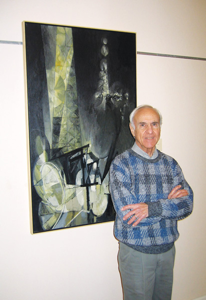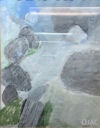Fort Worth Circle
American, (1928–2019)
Grammer, was born in Fort Worth, Texas, on October 2, 1928. He was raised in Fort Worth except for a short period of residence in Abilene. He graduated from R. L. Paschal High School in Fort Worth in 1945 and received a scholarship to Texas Wesleyan College (now Texas Wesleyan University), where he trained until 1947 with painter Kelly Fearing. Through Fearing, Grammer came into contact with other Fort Worth artists that rejected traditional depictions of Texas subject matter in favor of European-inspired modernism. Collectively, this close-knit group are remembered as the Fort Worth Circle or the Fort Worth School. Grammer was particularly close with Circle member Evaline Sellors, with whom he created masks and headdresses for a Reeder School performance in 1950.
Grammer worked as an architect’s assistant, set painter for the Fort Worth Opera, contract muralist, and window display designer for a downtown clothing retailer. Grammer was also an instructor for art appreciation classes conducted by the Fort Worth Art Association, taught painting at the Fort Worth Children’s Museum, and taught a weekly art class in Jacksboro beginning in 1948. His nighttime observations of lighted oil derricks along State Highway 199, seen on his bus rides from the Jacksboro art class, inspired Grammer to paint Derricks at Night in 1950, a Cubist-related composition that drew immediate praise and was the first of many other works by Grammer that pictured man-made structures or natural landscape elements set against night skies.
Grammer's 1952 oil painting Oil Derricks at Night, which was a descendant of his ealier painting Derricks at Night (1950). It was acquired by the Dallas Museum of Art for its permanent collection. Image available on the Internet and included in accordance with Title 17 U.S.C. Section 107.
Grammer obtained gallery representation when Betty McLean founded Dallas’s first contemporary art gallery in 1951 and began representing him along with five other members of the Fort Worth Circle. That same year, Grammer’s work debuted in New York City when it was included in the exhibition Newcomers: First Showing of a New Generation at Halpert’s Downtown Gallery. The following year, examples of his art were seen in an exhibition of paintings by Texas contemporary artists at the M. Knoedler & Company gallery in New York City. In late 1951 Grammer won a national scholarship competition that entitled him to a year of subsidized instruction at the Instituto Allende in San Miguel de Allende, Mexico. In 1954 he began courses on a scholarship at the Art Students League of New York, where he was instructed by Vaclav Vytlacil. He also studied at the New School for Social Research in New York.
Grammer and June Amos met as students in an art class at Paschal High School. They wed in New York City in July 1954. The couple initially planned to live in New York City for one year and then return to Texas; however, they ultimately decided to settle permanently in New York, with their apartment serving as home and studio.
Grammer's West from the Plaza (1957) is representative of Grammer's treatment of architectural subjects following his removal to New York. Image available on the Internet and included in accordance with Title 17 U.S.C. Section 107.
In 1954 Grammer took top prize in the watercolor division of New York’s Emily Lowe Award Competition with his two semi-abstract cityscapes inspired by New York area scenery. In November 1955 he won an honorable mention for an oil painting in the Fashion Group’s Fine Arts Project. Techniques that Grammer pioneered for depicting nighttime industrial scenes in Texas were well-suited for capturing the energy and architectural diversity of New York City. Representative works from this period included West from the Plaza (1957), 100 Church Street (1958), and Dockside Crane (1963). In 1963 the artist and his wife purchased an abandoned Presbyterian church in Cokesbury, New Jersey, and turned it into a vacation home and studio. The New Jersey countryside influenced a shift in the subjects of Grammer’s artwork from architecture toward landscapes and plant life.
His art was shown in galleries in New York, New Jersey, and Maine. In spite of his choice to permanently reside on the East Coast, Grammer remained in the public eye in his hometown of Fort Worth all of his life. He exhibited work in the juried Fort Worth Local Artists Show (later renamed Annual Exhibition of Painting and Sculpture by Artists of Tarrant County) almost every year from 1944 to 1967 and won several awards. The Fort Wort Art Association hosted two solo exhibitions of Grammer’s work at the Fort Worth Art Center in 1956 and 1963. The Fifth Avenue Gallery, co-owned by Fort Worth Circle artist Bror Utter, invited George Grammer to join its stable of Fort Worth artists at the gallery’s inception in 1959. Gallery-in-the-Square in Fort Worth showcased the work of George Grammer beginning in 1966 and organized two solo exhibitions—one in late 1966 and a second exhibit in the spring 1969. Texas Painting and Sculpture: 20th Century, a touring exhibition designed to showcase a wide range of twentieth-century Texas art, traveled the Lone Star State in 1971 and 1972. Included was George Grammer’s 1952 work, Oil Derricks at Night, a descendant of his earlier Derricks by Night painting. In spring 1979 the New Gallery in Fort Worth included works by Grammer in an exhibition of paintings. In mid-1980 the New Gallery organized a two-person exhibition comprised of paintings by Grammer and sculptures by Gene Owens. The same gallery, by then called the Fort Worth Gallery, hosted a solo exhibit of works by Grammer in 1984.
Moon Through a Winter Tree (1957). An example of Grammer's treatment of natural subjects. Image available on the Internet and included in accordance with Title 17 U.S.C. Section 107.
In 1986 the Old Jail Art Center in Albany, Texas, organized Beyond Regionalism: The Fort Worth School (1945–1955): A Texas Sesquicentennial Exhibition, presenting works by members of the Fort Worth Circle. This exhibition marked the first attempt by a Texas museum to codify the membership of the Circle and present a broad sampling of art associated with its heyday. Three paintings by Grammer from the years 1950 to 1952 were included in this exhibit.
In 2002 David Dike Fine Art in Dallas held a two-person exhibition, featuring works by Grammer and José Cisneros. In 2008 Grammer’s art was included in Intimate Modernism: Fort Worth Circle Artists in the 1940s, a retrospective exhibition organized by the Amon Carter Museum of American Art. The Old Jail Art Center featured his work in a solo exhibition, Texas Moderns: George Grammer, in 2014. In April 2017 his Fort Worth alma mater, Texas Wesleyan University, presented the retrospective exhibit George Grammer: Full Circle.
Paintings by Grammer are represented in the permanent collections of the Amon Carter Museum of American Art, Dallas Museum of Art, Longview Museum of Fine Arts, Modern Art Museum of Fort Worth, Old Jail Art Center, and San Antonio Art League & Museum.
Throughout his life after his move to New York, Grammer made frequent trips to Texas to visit family and friends, maintain gallery representation, and attend numerous art-related events. George Grammer died at the age of ninety in a hospital in New York City on May 20, 2019. He outlived his wife, June, by twenty-five years. He was the youngest member of the Fort Worth Circle and the last to pass away.
Source: Texas State Historical Association
Big City Canyon 1993.040
City Scape 2016.006
Landscape 1981.074
Male Nude Relaxing 2007.004
Tree and Ruin 2016.005
Vertical Skyline 1981.073
White Potatoes 1984.047






